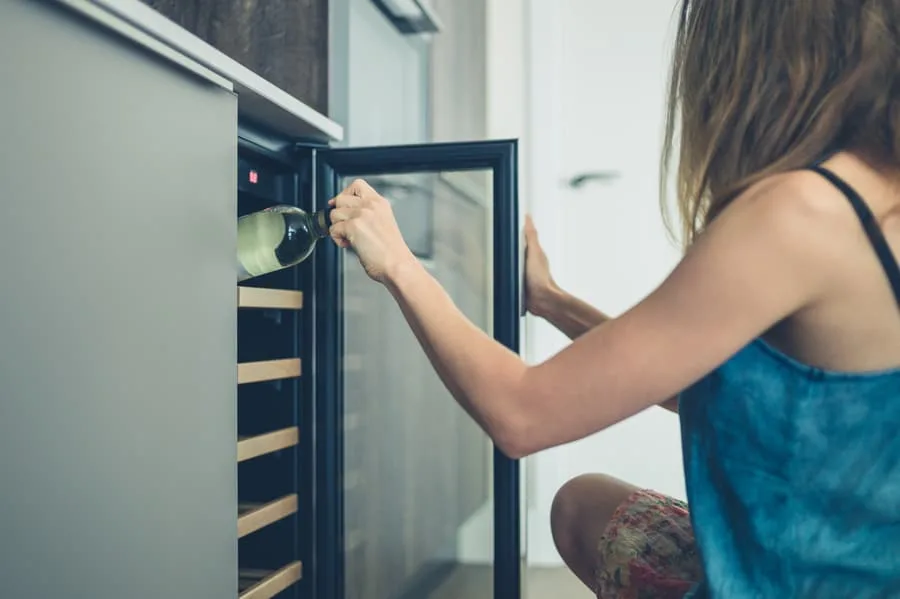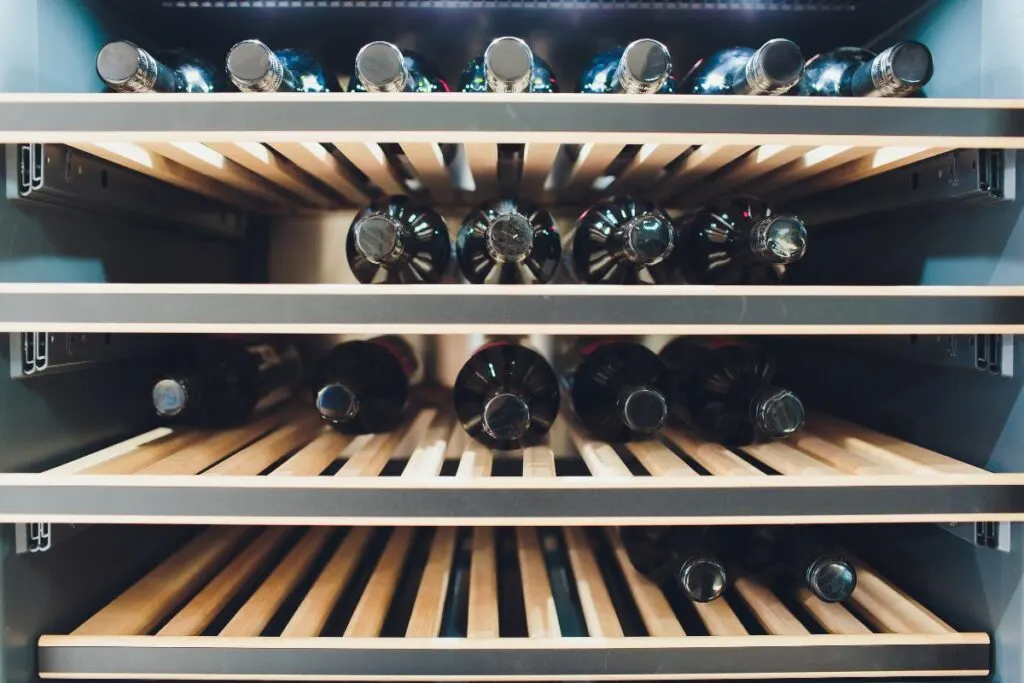As an Amazon Associate, I earn from qualifying purchases with no additional costs for you.
You’ve waited all day to sit back and relax with your favorite bottle of wine, only to come home to a puddle of water around your wine fridge. That’s right- your wine fridge has sprung a leak, and you’re unsure what’s going on and whether it’s affecting your wine or not. So, what’s the cause of all this excess water?
Why is my wine fridge leaking water? A wine fridge leaking water typically has too much condensation in the cooler. That excess moisture in the wine fridge makes its way out through a gap or leak. A gap around the door, ceiling, or floor of the wine fridge often causes condensation, which can be fixed with weather stripping. Most often, wine fridges leaking water is not a serious issue.
Nobody wants to see their prized wine possession springing a leak. Fortunately for the wine connoisseurs out there, we have come up with a handy list of simple solutions to fix the excessive condensation problem in your wine fridge.

TIP: If you want to check out the best refrigerator for wine storage, I recommend trying out the Avation (18 bottles) compressor refrigerator with Wi-fi smart app control cooling system. You can find this refrigerator by clicking here (Amazon link).
Why Your Wine Fridge is Leaking & How to Fix It
The main reason why any wine fridge ends up with a leak is that there is excess condensation building up inside the wine fridge. This can make the door appear foggy, as if you had just taken a hot shower and tried to look in the mirror.
However, this excess buildup of water will make its way to the outside of the wine fridge when there are gaps in the seal or the wine fridge itself is broken.
The best thing to do is to find out if there are any gaps or cracks by thoroughly inspecting your wine fridge. Then look at these quick and easy solutions to a wine fridge that is leaking:
You’re Opening the Wine Fridge Too Often

It’s okay to keep going back for seconds (and thirds or fourths) during your wine-sipping ventures but keep in mind that opening the wine fridge too often can lead to a buildup of water inside the wine fridge.
This is especially true if you live in a more humid climate where condensation forms quickly. So, what can you do to help with this issue? Well, there are a few ways to cut down on the amount of condensation building up from simply opening your wine fridge:
- Try not to open the wine fridge as much. This might be challenging- especially during a dinner party- but do the best you can to cut down on the number of times you open the fridge. You should see instant results.
- Place a bowl of baking soda in the wine fridge. Is there anything baking soda can’t do? Aside from being the go-to for all things cleaning and cooking, baking soda can also be used as a moisture absorber in your wine fridge.
- Add a silica packet. Did you know that sodium silica can absorb up to 40 times its
weight in moisture? Add a few packs to your wine fridge and see instant results. - Add calcium chloride packets. Your last- and possibly best choice- is to toss in a few packets of calcium chloride. Calcium chloride is known for its ability to absorb, so you can’t go wrong with this handy and hefty material.
TIP: Most wines go bad once you pop the cork within a day or so. But a Coravin Wine Preservation system (available for a great price on Amazon) can extend the life of your opened wine for weeks or even months. It is awesome. You should check it out to see if it fits your lifestyle.
Check the Seals
Wine fridges are constructed with one goal in mind: to keep humidity and moisture out and leave your wine at a perfect temperature.
So, when you’re struggling with an excessive buildup of moisture on the inside and outside of your wine fridge, you might want to double-check the construction.
What you will want to do is check the walls, ceiling, floors, and door of the wine fridge, paying extra close attention to the door.
These areas should have been designed with an airtight seal that acts as a moisture barrier. Any gaps or cracks in the seal will ultimately lead to a wine fridge leak.
- Gaps. It’s not completely uncommon for a seal to become wiggled a little bit out of place. If you’re struggling with a few gaps around the moisture barrier, simply try to push it back into place.
- Cracks or tears. If you notice cracks or tears in the seal, then pushing it back into place won’t solve anything. A worn-down moisture barrier will need to be replaced.
- Add extra moisture barrier layers. Certain areas around your wine fridge may be letting in extra air, causing condensation and leaking issue. One area you might want to consider placing an extra seal is along the center strip, where the door comes together when closed.
TIP: For more ideas on how to fix your refrigerator problems, read this article. This informative guide explains how to control the humidity in your wine fridge – don’t miss this!
Check for Dirty Seals
It’s not only about your seals being pushed into place and free of any tears, rips, or cracks. You should also check to make sure that there is no dirt buildup in or around the seals.
Too much dirt and grime along the seal will not allow the seal to adhere as well to the wine fridge. Make sure the seals are thoroughly cleaned from time to time–and especially when you see a leak.
Check Your Wine Fridge

If your seals look a-okay and you’re still struggling with a bit of a leak, then your actual wine fridge may be to blame. Carefully look around your wine fridge to see if there are any signs of damage. Even small cracks in your fridge can lead to leakage and should be repaired.
If you notice that there is damage to the wine fridge, the best thing to do is to call the manufacturer and see if they have any recommendations on fixes.
However, for the most part, you will likely need to acquire a new device as cracks and other issues are challenging to repair and might not leave you with an airtight seal.
TIP: Wine bottles could break if they are not stored properly. Find out the correct way to store them here. Do you really need different wine glasses for different wines? This article explains!
TIP: A suitable wine glass is the basis for enjoying well-being while drinking your favorite wine variety. Here are our favorite ones (Amazon link):
- Bormioli Rocco Crystal Wine Glasses: A set of eight elegant and traditional wine glasses made in Italy for a reasonable price.
- Riedel VINUM Wine Glasses: Luxury set of two wine glasses suitable for any occasion. We just love them!
- Schott Zwiesel Tritan Crystal Glasses: If you like unusual alternatives, a set of six stemless glasses made of crystal glass.
Check the Drainpipe
Another area you won’t want to overlook is the drainpipe. When the drainpipe is clogged, the wine fridge will not be able to get rid of the excessive condensation, which can lead to a leak.
Some clogs may require professional help, but before calling a plumber or the manufacturer, you can attempt to clear the clog by doing the following:
- Remove the drainpipe from the wine fridge.
- Use a snake to try and push the clog through the drainpipe.
- Toss a few sprinkles of baking soda into the drainpipe.
- Pour two cups of hot water down the drainpipe.
- Check to see if the clog is gone. If not, repeat the process.
Again, if you are unable to handle the clog on your own, then there may be something wrong with the drainpipe, or something has become lodged that requires professional help.
Recommendation box: Everything you need to enjoy your wine as much as possible. All recommended products are personally tested and regularly used by experts from this website (Amazon links):
> Ivation Wine Cooler – Energy-efficient wine cooler for 18 bottles with Wi-fi smart app control cooling system.
> Wine Rack – Beautiful, elegant wood rack for up to 7 bottles and the choice of vertical or horizontal storage.
> Durand Wine Opener – Classic vintage wine opener (we like all these classic staff).
> YouYah Iceberg Wine Decanter – The most beautiful and handy wine decanter we personally use.
> Bormioli Rocco Wine Glasses – A set of eight elegant and traditional wine glasses made in Italy.
> Vintorio Wine Aerator – Simple but really useful wine aerator for a reasonable price.
> The Original Vacu Vin Wine Saver – The best wine saver on the market in a package with two vacuum stoppers and two wine servers.
And if you want to become a true connoisseur of wine, we recommend reading the book Wine Folly: The Essential Guide to Wine (Amazon link), where you will find all the information you need about winemaking, wine varieties, flavors, and much more.
Change the Temperature
Now, this tip probably won’t be able to entirely solve a leak problem, but it’s something to consider when you’re battling condensation.
It’s a good idea to have your wine fridge’s minimum set point raised to around 51 degrees or higher. Leaving your wine fridge at such a temperature will help to reduce the chances of too much condensation causing a problem.
TIP: If your wine is fermenting inside the bottle, read this article to find out why! Do you know the correct temperature to store your favorite wine? Read this guide for everything you need to know.
Conclusion
A leaking wine fridge may seem like something to panic about, but it’s not. Most of the time, leaks from a wine fridge are simply due to too much condensation that is seeping out with or without damage to your seals and system.
The best thing to do is to cut down on how much you open the door, check for clogs in the drainpipe, and make sure that there are no gaps or cracks in the seal.
TIP: Check out this page for a complete list of wine products and accessories I love. You’ll find my recommendations for wine refrigerators, decanters, and aerators and the best place to buy wine online. Click here to see the complete listing.
